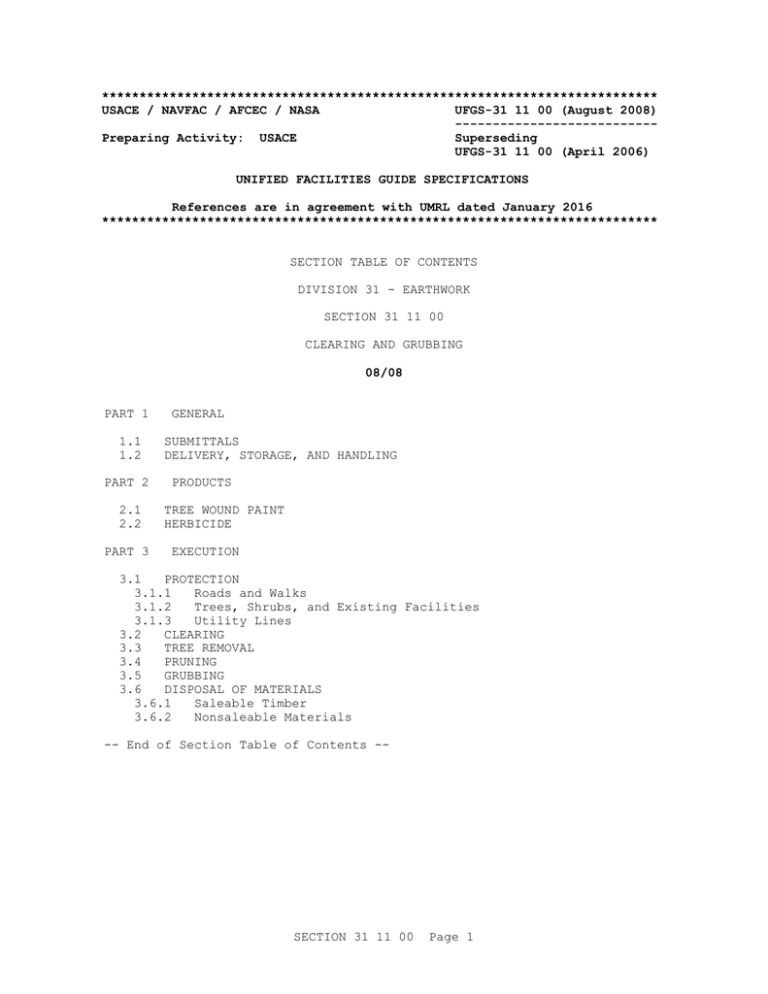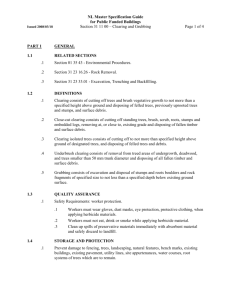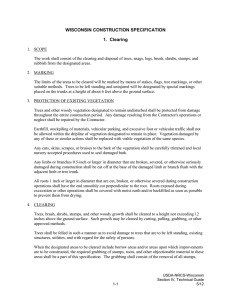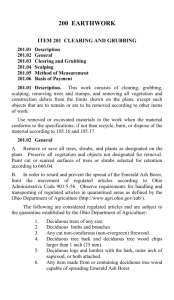************************************************************************** USACE / NAVFAC / AFCEC / NASA ...
advertisement

**************************************************************************
USACE / NAVFAC / AFCEC / NASA
UFGS-31 11 00 (August 2008)
--------------------------Preparing Activity: USACE
Superseding
UFGS-31 11 00 (April 2006)
UNIFIED FACILITIES GUIDE SPECIFICATIONS
References are in agreement with UMRL dated January 2016
**************************************************************************
SECTION TABLE OF CONTENTS
DIVISION 31 - EARTHWORK
SECTION 31 11 00
CLEARING AND GRUBBING
08/08
PART 1
1.1
1.2
PART 2
2.1
2.2
PART 3
GENERAL
SUBMITTALS
DELIVERY, STORAGE, AND HANDLING
PRODUCTS
TREE WOUND PAINT
HERBICIDE
EXECUTION
3.1
PROTECTION
3.1.1
Roads and Walks
3.1.2
Trees, Shrubs, and Existing Facilities
3.1.3
Utility Lines
3.2
CLEARING
3.3
TREE REMOVAL
3.4
PRUNING
3.5
GRUBBING
3.6
DISPOSAL OF MATERIALS
3.6.1
Saleable Timber
3.6.2
Nonsaleable Materials
-- End of Section Table of Contents --
SECTION 31 11 00
Page 1
**************************************************************************
USACE / NAVFAC / AFCEC / NASA
UFGS-31 11 00 (August 2008)
--------------------------Preparing Activity: USACE
Superseding
UFGS-31 11 00 (April 2006)
UNIFIED FACILITIES GUIDE SPECIFICATIONS
References are in agreement with UMRL dated January 2016
**************************************************************************
SECTION 31 11 00
CLEARING AND GRUBBING
08/08
**************************************************************************
NOTE: This guide specification covers the
requirements for clearing and grubbing.
Adhere to UFC 1-300-02 Unified Facilities Guide
Specifications (UFGS) Format Standard when editing
this guide specification or preparing new project
specification sections. Edit this guide
specification for project specific requirements by
adding, deleting, or revising text. For bracketed
items, choose applicable items(s) or insert
appropriate information.
Remove information and requirements not required in
respective project, whether or not brackets are
present.
Comments, suggestions and recommended changes for
this guide specification are welcome and should be
submitted as a Criteria Change Request (CCR).
**************************************************************************
PART 1
GENERAL
**************************************************************************
NOTE: When this specification is used for hazardous
waste site remediations, define what materials
generated from clearing, grubbing, and tree removal
are contaminated and what materials are
non-contaminated. The decision on how to define
contaminated and non-contaminated materials must be
made by the appropriate regulatory authorities and
documented in the design analysis.
The following information must be shown on the
project drawings:
1.
Limits of clearing
2.
Limits of grubbing
SECTION 31 11 00
Page 2
3.
Trees and shrubs to remain in area to be cleared
4. Trees to be removed in areas which are not to be
cleared
5. Describe size, density, and type of trees to be
cleared and grubbed.
**************************************************************************
1.1
SUBMITTALS
**************************************************************************
NOTE: Review submittal description (SD) definitions
in Section 01 33 00 SUBMITTAL PROCEDURES and edit
the following list to reflect only the submittals
required for the project.
The Guide Specification technical editors have
designated those items that require Government
approval, due to their complexity or criticality,
with a "G." Generally, other submittal items can be
reviewed by the Contractor's Quality Control
System. Only add a “G” to an item, if the submittal
is sufficiently important or complex in context of
the project.
For submittals requiring Government approval on Army
projects, a code of up to three characters within
the submittal tags may be used following the "G"
designation to indicate the approving authority.
Codes for Army projects using the Resident
Management System (RMS) are: "AE" for
Architect-Engineer; "DO" for District Office
(Engineering Division or other organization in the
District Office); "AO" for Area Office; "RO" for
Resident Office; and "PO" for Project Office. Codes
following the "G" typically are not used for Navy,
Air Force, and NASA projects.
An "S" following a submittal item indicates that the
submittal is required for the Sustainability
Notebook to fulfill federally mandated sustainable
requirements in accordance with Section 01 33 29
SUSTAINABILITY REPORTING.
Choose the first bracketed item for Navy, Air Force
and NASA projects, or choose the second bracketed
item for Army projects.
**************************************************************************
Government approval is required for submittals with a "G" designation;
submittals not having a "G" designation are for [Contractor Quality Control
approval.][information only. When used, a designation following the "G"
designation identifies the office that will review the submittal for the
Government.] Submittals with an "S" are for inclusion in the
Sustainability Notebook, in conformance to Section 01 33 29 SUSTAINABILITY
REPORTING. Submit the following in accordance with Section 01 33 00
SUBMITTAL PROCEDURES:
SECTION 31 11 00
Page 3
SD-03 Product Data
Nonsaleable Materials; G[, [_____]]
SD-04 Samples
Tree Wound Paint
Herbicide
1.2
DELIVERY, STORAGE, AND HANDLING
Deliver materials to store at the site, and handle in a manner which will
maintain the materials in their original manufactured or fabricated
condition until ready for use.
PART 2
2.1
PRODUCTS
TREE WOUND PAINT
Submit samples in cans with manufacturer's label of bituminous based paint
of standard manufacture specially formulated for tree wounds.
2.2
HERBICIDE
**************************************************************************
NOTE: Specify by generic name. Spraying of
herbicides should be prohibited near vegetation to
be saved; if deemed necessary, this may be made more
controllable by careful selection of herbicides.
Recommended types and rate of coverage should be
obtained from recognized authorities. When grubbing
is included as part of the contract, delete
requirements for herbicides.
**************************************************************************
[_____]. Comply with Federal Insecticide, Fungicide, and Rodenticide Act
(Title 7 U.S.C. Section 136) for requirements on Contractor's licensing,
certification and record keeping. Contact the command Pest Control
Coordinator prior to starting work. Submit samples in cans with
manufacturer's label.
PART 3
3.1
3.1.1
EXECUTION
PROTECTION
Roads and Walks
Keep roads and walks free of dirt and debris at all times.
3.1.2
Trees, Shrubs, and Existing Facilities
[Provide protection in accordance with Section 01 57 19 TEMPORARY
ENVIRONMENTAL CONTROLS.] [Protect trees and vegetation to be left standing
from damage incident to clearing, grubbing, and construction operations by
the erection of barriers or by such other means as the circumstances
require.]
SECTION 31 11 00
Page 4
3.1.3
Utility Lines
Protect existing utility lines that are indicated to remain from damage.
Notify the Contracting Officer immediately of damage to or an encounter
with an unknown existing utility line. The Contractor is responsible for
the repairs of damage to existing utility lines that are indicated or made
known to the Contractor prior to start of clearing and grubbing
operations. When utility lines which are to be removed are encountered
within the area of operations, notify the Contracting Officer in ample time
to minimize interruption of the service. Refer to Section 01 30 00
ADMINISTRATIVE REQUIREMENTS and Section 01 57 19 TEMPORARY ENVIRONMENTAL
CONTROLS for additional utility protection.
3.2
CLEARING
**************************************************************************
NOTE: Any clearing which requires the removal and
disposal of structures that obtrude, encroach upon,
or otherwise obstruct the work should be indicated
and specified in the Section 02 41 00 {DEMOLITION}
{AND} {DECONSTRUCTION}.
When grubbing is included as part of the contract,
delete requirements for herbicides.
Where loose rocks, boulders, or rock piles are
present on the surface of the areas designated to be
cleared, appropriate provisions will be inserted to
provide for the disposal of such material. Where
stone occurs that can be economically used in the
project, provision will be made for the proper
stockpiling of such stone in a designated area
adjacent to the location of its intended use.
If only minor structures will be encountered, such
work may be included. Where large structures are to
be demolished, the requirements of this work will be
covered in Section 02 41 00 {DEMOLITION} {AND}
{DECONSTRUCTION}.
Herbicides intended for controlling vegetative
growth should be specified and used with caution on
hazardous waste sites to avoid contributing to site
contamination.
**************************************************************************
Clearing shall consist of the felling, trimming, and cutting of trees into
sections and the satisfactory disposal of the trees and other vegetation
designated for removal, including downed timber, snags, brush, and rubbish
occurring within the areas to be cleared. [Clearing shall also include the
removal and disposal of structures that obtrude, encroach upon, or
otherwise obstruct the work.] Trees, stumps, roots, brush, and other
vegetation in areas to be cleared shall be cut off flush with or below the
original ground surface, except such trees and vegetation as may be
indicated or directed to be left standing. Trees designated to be left
standing within the cleared areas shall be trimmed of dead branches 40 mm
1-1/2 inches or more in diameter and shall be trimmed of all branches the
heights indicated or directed. Limbs and branches to be trimmed shall be
neatly cut close to the bole of the tree or main branches. Cuts more than
SECTION 31 11 00
Page 5
40 mm 1-1/2 inches in diameter shall be painted with an approved tree-wound
paint. Apply herbicide [at the rate of [_____]] [in accordance with the
manufacturer's label] to the top surface of stumps designated not to be
removed.
3.3
TREE REMOVAL
Where indicated or directed, trees and stumps that are designated as trees
shall be removed from areas outside those areas designated for clearing and
grubbing. This work shall include the felling of such trees and the
removal of their stumps and roots as specified in paragraph GRUBBING.
Trees shall be disposed of as specified in paragraph DISPOSAL OF MATERIALS.
3.4
PRUNING
[Prune] [Trim] trees designated to be left standing within the cleared
areas of dead branches 38 mm 1-1/2 inches or more in diameter; and trim
branches to heights and in a manner as indicated. Neatly cut limbs and
branches to be trimmed close to the bole of the tree or main branches.
Paint cuts more than 32 mm 1-1/4 inches in diameter with an approved tree
wound paint.
3.5
GRUBBING
**************************************************************************
NOTE: Delete the second sentence when this work is
included under another section or sections of the
project specification.
For hazardous waste sites, the amount of grubbing
performed in contaminated areas should be minimized
due to potential added costs for disposal of
contaminated materials and health and safety
concerns.
**************************************************************************
Grubbing consists of the removal and disposal of stumps, roots larger than
75 mm 3 inches in diameter, and matted roots from the designated grubbing
areas. Remove material to be grubbed, together with logs and other organic
or metallic debris not suitable for foundation purposes, to a depth of not
less than 455 mm 18 inches below the original surface level of the ground
in areas indicated to be grubbed and in areas indicated as construction
areas under this contract, such as areas for buildings, and areas to be
paved. Fill depressions made by grubbing with suitable material and
compact to make the surface conform with the original adjacent surface of
the ground.
3.6
3.6.1
DISPOSAL OF MATERIALS
Saleable Timber
**************************************************************************
NOTE: Do not include this article in NAVFAC SE
projects. Instead, notify the Project Manager,
obtain an estimated value if timber is saleable, and
include the following in the BASIS OF BIDS
statement: "Bidders are advised that there is
marketable standing timber, having fair market value
which the Government appraises to be $_____, within
SECTION 31 11 00
Page 6
the limits of construction. The Contractor is
required to pay the appraised amount to the
Government within 30 days after notice to proceed
has been given. This is to be deposited in the
Navy's forestry account."
Verify with the natural resources office for the
installation the most appropriate option.
1. The first option should be used when the
Contractor will be required to cut and stack
saleable lumber for the Government.
2. The second option should be used when the
Government will harvest saleable timber prior to
award of the contract.
3. The third option should be used when the
Contractor will be required to pay the Government
appraised amount for the saleable timber on the
project site. Use of the third option must be
approved by EFD/EFA legal counsel for NAVFAC
projects. When the felled timber has a distinct
commercial value, the disposal of such timber may
left to the Contractor provided the Contracting
Officer has reasonable assurance that the bidders
will consider the value of the salvageable timber
estimating their bids. An applicable length will
inserted in the blank. At hazardous waste sites,
timber removed from areas of contamination is
normally not salable due to liability concerns.
an
be
in
be
4. The fourth option should be used when the
disposition of cleared materials is left to the
Contractor's discretion. When the timber that can
be obtained from felled trees is not of sufficient
commercial value to warrant salvaging, this
paragraph may be deleted, and the Contractor
permitted either to make use of or to dispose of
such timber in an approved manner.
When this specification is being used for the
remediation of hazardous waste sites, this paragraph
should define how both contaminated and
non-contaminated materials will be disposed of. As
an alternative, disposal requirements could be
outlined in a separate section. The design analysis
should document how both contaminated and
non-contaminated materials will be disposed of.
**************************************************************************
1. [Consider felled timber from which saw logs, pulpwood, posts, poles,
ties, or fuelwood can be produced as saleable timber. Trim limbs and tops,
and saw into saleable lengths of [_____] meters feet for saw logs, [_____]
meters feet for pulpwood, [_____] meters feet for poles, [_____] meters feet
for ties, and [_____] meters feet for fuelwood, and stockpile adjacent to
the site. The stockpile timber will remain the property of the Government.]
2. [The Government will, by separate contract, harvest all saleable timber
SECTION 31 11 00
Page 7
from the project site. All remaining timber, limbs, tops, stumps, and
debris shall be cleared and disposed of by the Contractor as specified.]
3. [All timber removed from the project site shall become the property of
the Contractor. Reimburse the Government for the value of the timber
(which the Government has appraised at $[_____]). Submit payment to the
Contracting Officer by cashier's or certified check in the amount of
$[_____], made payable to the U.S. Treasury. Payment shall be made within
30 days of the Notice to Proceed. The Contracting Officer shall deposit
the check into the [Navy Forestry] [_____] account.]
4. [All timber on the project site noted for clearing [and grubbing] shall
become the property of the Contractor, and shall be removed from the
project site and disposed of off stations.]
3.6.2
Nonsaleable Materials
Written permission to dispose of such products on private property shall be
filed with the Contracting Officer. Logs, stumps, roots, brush, rotten
wood, and other refuse from the clearing and grubbing operations, except
for salable timber, shall be disposed of [in the designated waste disposal
area] [outside the limits of Government-controlled land at the Contractor's
responsibility] [by burning], except when otherwise directed in writing.
Such directive will state the conditions covering the disposal of such
products and will also state the areas in which they may be placed. [Burn
refuse to be burned at specified locations and in a manner to prevent
damage to existing structures and appurtenances, construction in progress,
trees, and other vegetation. Comply with all Federal and State laws and
regulations and with reasonable practice relative to the building of
fires. Burning or other disposal of refuse and debris and any accidental
loss or damage attendant thereto shall be the Contractor's responsibility.]
-- End of Section --
SECTION 31 11 00
Page 8






